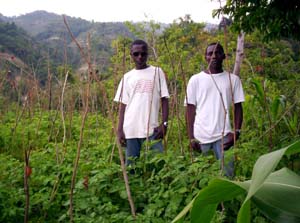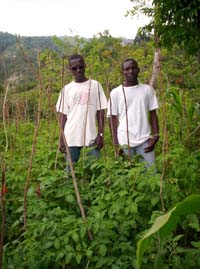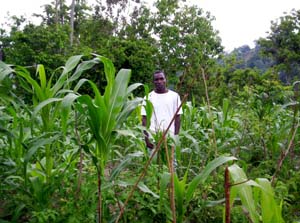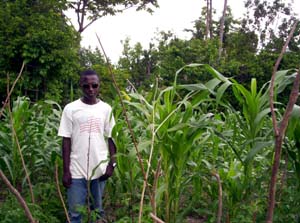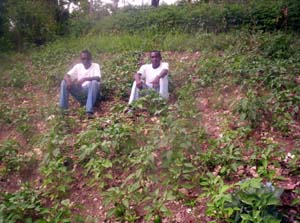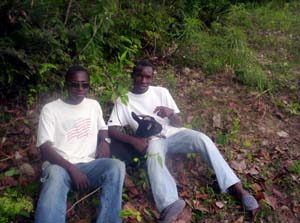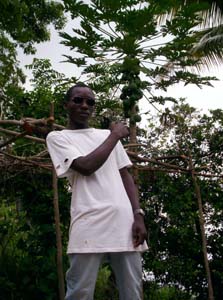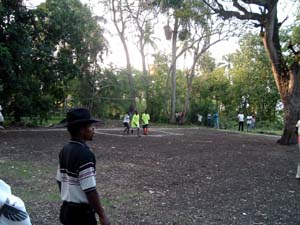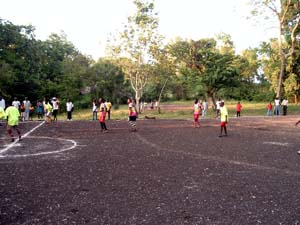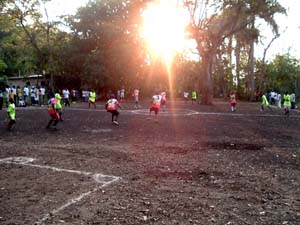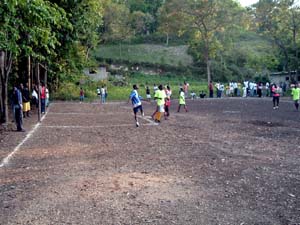Guifobert’s suggestion conveyed a lot. He is a fifth-grader at the Matènwa Community Learning Center (www.matenwa.org), and he and his class were working with me to make a map of the property his school sits on. It was our second day of work.
We had measured the back border of the property to be 98 students long by lining one after another, spreading our arms out as wide as we could. We decided to ignore the differences in size that are predictable in a fifth grade class, no to mention the way Enel and I skewed the numbers. We had already traced the front wall on the blackboard using a scale of three centimeters to one student. We had fixed the angles at the corners of the property by using a pair of pencils, opening them as though they were a compass and copying the angle they formed. We had then traced one side of the property and were prepared to trace the back.
That’s when we ran out of space. We needed enough space to trace a line 294 centimeters long, but ran into the edge of the blackboard just before we reached 200. I asked the class what we should do, and Guifobert suggested that we bend the line inward so that it would fit on the board.
Enel, who is the school’s fifth-grade teacher, and I had been planning the class for about a month. He and I had spoken about how struck he had been when he visited the States by the use Americans make of maps. He was surprised to see how Americans he knows can find their ways around unfamiliar areas by looking at maps and reading signs. I had talked about the vague memories I still have of the importance that was given to map reading when I was in elementary school. We had started discussing whether there was something we could do with his students that would help them learn to use maps as I do.
This is what we came up with: We would spend a class sitting outside in the schoolyard, scratching a map of the school into the ground with a stick. We would trace it as we sat on benches in a circle around it. Everyone would have a chance to take the stick, erase previous work, and trace out new suggestions. Enel and I would push the students to argue through their disagreements so that the class would reach rough consensus on every point: the size and position of each school building, and of everything important in the schoolyard, as well as the outline of the schoolyard itself. After that, every student would copy the map onto a piece of paper. They would thus each have a map of their own. We then sent them home with an assignment to draw a map showing the route they take from home to school.
Drawing the original map in the dirt went well. Though it took a few minutes for students to get involved, soon they were grabbing for the stick each time one of them finished with it, jumping to make a correction or add a new detail. There was a lot of discussion of the shape of the schoolyard, and lots more about how to represent the school’s principle building.
The latter point was especially striking. Most of them wanted to represent the building with a drawing that showed it as they see it when standing in front, as though one were to draw a map of Manhattan with pictures of the front of each skyscraper showing where it stands. I asked them to consider what the building would look like if they were looking at it from the air, where they would have to be to see the schoolyard the way we had drawn it. One or two were able to trace a bird’s eye view of the school, and others were willing to agree with them, but it was clear enough that this wasn’t how they saw things.
Things started to get really interesting when they began to copy the map onto their own sheets of paper. The schoolyard has an odd shape. The front wall is much shorter than the back fence. As you face the school, the left-hand boundary slants inward making an acute angle with the front of the property. Its short – only about fifteen students long – and then makes an obtuse angle with the back of the property, which extends well off towards the right. The right-hand boundary then curves inward to meet the front border.
Most of the kids, however, traced the property as a rectangle, drawing its boundary a quarter- to a half-inch inside the edge of the paper they used. A few introduced a slight irregularity in the shape, pinching the boundaries on the back right-hand side to leave a little bulge. But those bulges were nothing like the way the property extends. It was as though neither the shape of the property nor the shape of the map they had already drawn together had anything to do with their choice. It was the shape of the paper that was guiding them.
The maps they drew of their routes from home to school were just as telling. They showed roads curving gracefully, positioning the houses evenly around the page. So when Guifobert suggested that we simply bend the back boundary inward to fit on the blackboard, he was neither kidding nor trying to take an easy way out of the problem we found ourselves facing. He was expressing the way he and most of his classmates were approaching the task. They were thinking like artists, arranging objects on a canvas.
Enel and I had originally planned to move quickly from what we naively expected to be simple maps of the students’ routes to school to a writing assignment: We would ask the students to write out directions. But it turns out that things will need to move forward more slowly than that.
Two things are clear. On one hand, we need to keep them working together, whether in small groups or as a single large class. The chance to argue with one another, to correct one another and be corrected, took them much farther as mapmakers than any was able to travel by themselves.
One the other hand, we need to help the students think more clearly about the difference between drawings and maps. We need to help them draw more from observation, and less from the constraints that the paper in front of them provides. Taking the trouble to measure out the schoolyard with their bodies might have been a first step. As they work to infuse their maps with more information about distances, sizes, and shapes, they may become more inclined to impose their vision on the paper they use.
If nothing else, stretching ourselves hand-to-hand around the schoolyard was lots of fun.
